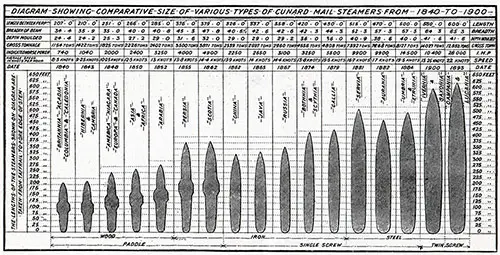The Story of the Cunard Line - 1902
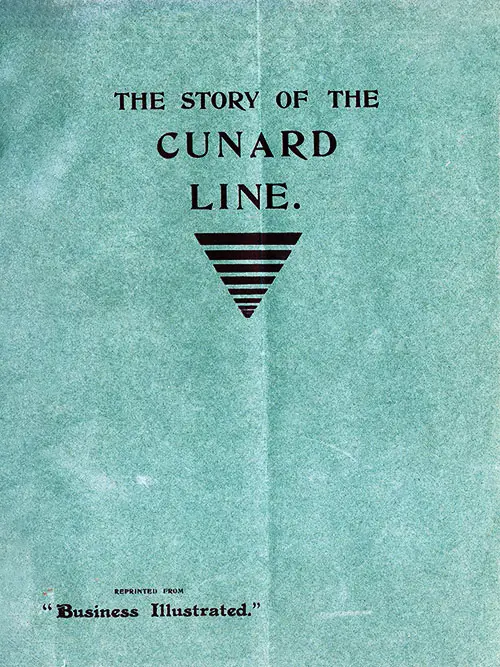
Front Cover, The Story of the Cunard Line, Reprinted From "BUSINESS ILLUSTRATED". December, 1902. GGA Image ID # 100243bf8e
Cunard Steamship Company, Limited, one of the oldest and most famous of British steam navigation undertakings elected to remain independent and outside the scope of the great Trust. This is their Story as published by BUSINESS ILLUSTRATED. December 1902. Lavishly Illustrated including Interior Photographs.
THE STORY OF THE CUNARD LINE
In the stirring story of ocean steamship enterprise the year 1902 will ever remain one of remarkable memories. During this year the supremacy of Great Britain in the Atlantic shipping trade has, for the first time, been seriously threatened.
Even as it is, the blandishments of American capital, handled on Napoleonic lines, and the fascinating possibilities of enterprise on a colossal scale, have together succeeded in absorbing within one huge combination several British Atlantic steamship lines, which' had previously been engaged in active coin-petition.
As was to be expected, this proceeding excited an amount of sensational interest which was unprecedented in the history of the shipping industry.
Happily the Cunard Steamship Company, Limited-- one of the oldest and most famous of British steam navigation undertakings--was one of those concerns which elected to remain independent and outside the scope of the great Trust; and, with the support and co-operation of the British Government, it has, within the past few months, entered upon a new chapter in its history, under conditions which are likely to maintain the splendid traditions of the Cunard Line.
The Founders of the Cunard Line
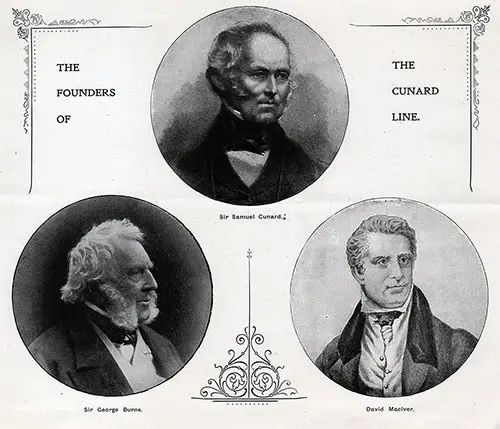
Clockwise from the top: Sir Samuel Cunard , David MacIver , and Sir George Burns. GGA Image ID # 100264e46e
In view of what follows in the course of this article, the terms of the arrangement concluded with His Majesty's Government may advisedly be recapitulated here.
The Cunard Company is to add to its fleet two large steamers of high speed for the Atlantic trade, and has pledged itself to remain a purely British undertaking for a period of twenty years from the completion of the second of these vessels, alike as regards the management, the shares, and the vessels of the Company.
During the currency of this arrangement the Company holds the whole of its fleet, including the two new vessels, and all others as built, at the disposal of the Government, who are at liberty to charter or purchase all or any of these vessels. The Cunard Company also undertakes not to unduly raise freights, or to give preferential rates to foreigners.
The Government on their part will supersede the present Admiralty subvention by the payment to the Cunard Company of the sum of £150,000 per annum, and will also lend the Company the necessary funds to enable it to construct the two new vessels, charging interest at the rate of 2 3/4 per cent. per annum, the security for the loan being a first charge on the two vessels, the Company's present fleet and its general assets.
Altogether the arrangement is one which is creditable alike to His Majesty's Government and to the Cunard Company. It is one, moreover, which is fraught with great possibilities.
It may, for one thing, be the precursor of means which will repair those disabilities from which British ship owners have long suffered in comparison with the ship owners of rival nations, whose efforts are supported by the bounty system.
It is the existence of this system in connection with the ocean steamships of other countries which, amongst other effects, has temporarily deprived British ship owners of the honor of being the holders of the record for speed in crossing the Atlantic, which it was their proud boast to possess for many a year.
No doubt the new vessels to be added to the Cunard fleet will once more secure this honor for British liners. In any case, the circumstances in which the Cunard Company now finds itself placed are eminently calculated to foster that spirit of enterprise for which the Cunard Line has always been celebrated.
The close of the year 1902—marking as it does a period which has been fraught with much momentous change to British shipping and allied interests—seems, then, to form an appropriate juncture at which briefly to review the history of the Great Atlantic Ferry.
In a fuller measure, tell the story of the Cunard Line, which has filled so prominent a place in the annals of British shipping. The occasion, too, is none the less opportune because it closely synchronises with a memorable period in later British history—the Coronation of King Edward VII.
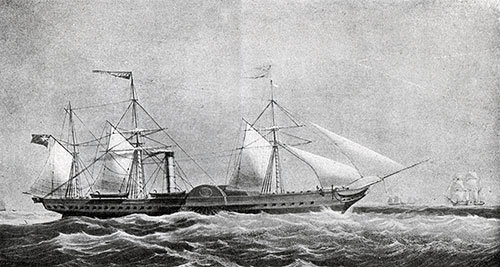
The First Cunarder: The Britannia. GGA Image ID # 100209d6d6
The first voyage of the Britannia (Shown Below), the pioneer vessel of the Cunard fleet, in 1840, deserves in many respects to rank not only as one of the great events of the Nineteenth Century, but also as one of the epoch-marking incidents in the history of civilization. It signalized the dawn of that organized ocean travel of which there have been since such mighty developments.
Rather more than a score of years previously, the Savannah, an unpretentious steamship of some 350 tons burthen, made an adventurous passage from Savannah to Liverpool, but she did not rely solely upon her paddle wheels; indeed, she trusted entirely to her sails when the weather was " dirty."
It was not, however, until the 4th of April, 1838, that any further steam venture of the kind was made. On that date the Sirius left London for New York, with ninety-four passengers aboard, and she was followed from Bristol four days later by the more historic Great Western -- the first steam vessel specifically built for the Atlantic passage.
The Great Western did her journey in fifteen days--in two days less than the Sirius--and with still 200 tons of coal left in her bunkers. This result was regarded as passing wonderful, for had not one of the greatest scientific men of the time " proved " to the satisfaction of most of the world that no steamer could carry coal enough to feed her fires for a single trip across the Atlantic ?
Amongst the few skeptics as to the truth of this pronouncement was Mr. Samuel Cunard, who for several years previously had quietly been nursing a scheme for organizing a regular. service of Trans-Atlantic mail steamers.
Mr. Cunard, who was once described during the fifties as being "a small, grey-haired man of quiet manners, and not overflowing speech," was born in 1787, in Halifax, Nova Scotia, where his father, a Philadelphia merchant, had settled.
Mr. Samuel Cunard had been engaged in conducting the mail service between Boston, Newfoundland and Bermuda, and when the British Government intimated their disposition to transfer the carrying of the mails between Liverpool, Halifax, Boston and Quebec from the old Government " coffin brigs," as they were irreverently called, whose passage averaged six or eight weeks, to a steam packet service, if a suitable tender were submitted, he thought the time had arrived for action.
Diagram showing the Growth in Dimensions of the Cunard Liners from 1840-1900. GGA Image ID # 100231e621
The merchants and ship owners of Halifax, however, did not look with favor upon his scheme, and so he crossed over to England, where he was fortunate enough to become acquainted with Mr. Robert Napier, famous as a Clyde engineer and shipbuilder, and through him with Mr. George Burns, of Glasgow, and Mr. David Maclver, of Liverpool, both of them well-known ship owners engaged in the coasting trade between England, Scotland and Ireland.
A few days later a scheme was developed and a capital of £270,000 subscribed, while shortly afterwards a seven years' contract between the British Government, on the one hand, and Messrs. Samuel Cunard, George Burns, and David Maclver (whose portraits appear on page 4), on the other, was signed, and the Cunard Line established, the title at first selected being "
The British and North American Royal Mail Steam Packet Company." Meanwhile, Mr. Cunard opened an office in London, Mr. Burns presided at the headquarters of the Company, which were located in Glasgow, and Mr. Maclver remained in Liverpool, there to prepare for the inauguration of the service.
The policy of the Company from the beginning was the sound one, with which the fortunes of the Cunard Line have ever since been identified, that in the building and equipment of their ships and in their manning and service, no expense should be spared in securing the best value obtainable, and in maintaining the highest possible standard.
The service was to commence with four steamers, and the Admiralty was to subsidize the Company to the extent of £81,000 a year. The keels of four wooden paddle steamers--the Britannia, Acadia, Caledonia and Columbia--were promptly laid down, and their building marked a noteworthy achievement in the naval architecture of that period.
It is interesting, by way of contrast with the vastly greater things of to-day, to glance at the dimensions of the Britannia, of which an illustration appears above. The good ship measured 207 feet long by 34 feet 4 inches broad by 24 feet 4 inches deep.
She was 1,154 tons burthen, and her engines were of 740 indicated horse power. Her speed average was 8 1/2 knots per hour on a consumption of 38 tons of coal per day. The three other vessels were practically identical in their dimensions and equipment with the Britannia.
It was on " Independence Day," July 4th, 1840, that the Britannia left her moorings in the Mersey on her pioneer voyage and with 63 passengers on board, amidst the jubilations of an immense concourse of people.
The crossing of the Atlantic was safely accomplished in 14 days 8 hours, and the arrival of the vessel in Boston Harbor was the signal for an almost frantic outburst of enthusiasm on the part of the inhabitants of " the Hub of the Universe."
Salutes were fired and a public banquet held, and Mr. Cunard, who accompanied the Britannia on her maiden trip, was made the hero of the moment. It is recorded, indeed, that within twenty-four hours of his landing on American soil, he was made the recipient of as many as 1,800 separate invitations to dinner--probably a record in that form of gastronomic honor which proved an embarras des richesses ('embarrassment of riches') to the modest but enterprising ship owner.
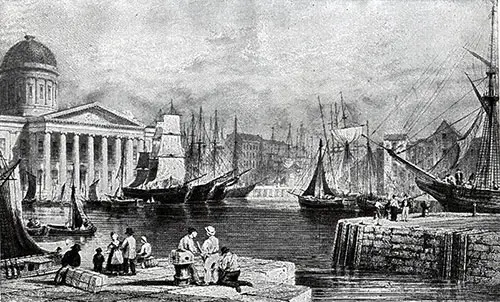
A View of Liverpool Harbor in 1837. GGA Image ID # 100099e821
With the inauguration of steam navigation between this country and America there also commenced a new era in the shipping trade and resources of the Port of Liverpool.
The illustration below, reproduced from an old picture, represents the appearance of Liverpool Docks in the year 1837, just three years before the Britannia made its historic pioneer voyage. When compared with the aspect of the river and port at the present time, it would be difficult to imagine a more striking metamorphosis.
Today the magnificent docks extend along the Liverpool shore of the Mersey for more than seven miles, and on the Birkenhead side for one mile before turning inland for another couple of miles.
The Liverpool Dock Estate, with its acres upon acres of warehouses, may be regarded as one of the modern wonders of the world, while the Landing Stage, part of which is shown in the illustration below, is " the most extensive floating marine parade in the world," measuring, as it does, as many as 2,463 feet long by 80 feet broad.
The overhead electric railway, seven miles in length along the line of the docks, is the only one of its kind in Europe. Last year's statistics show that the registered tonnage of Liverpool aggregated 26,616,610 tons, the population of the city, the third largest in the Kingdom, being over 700,000.
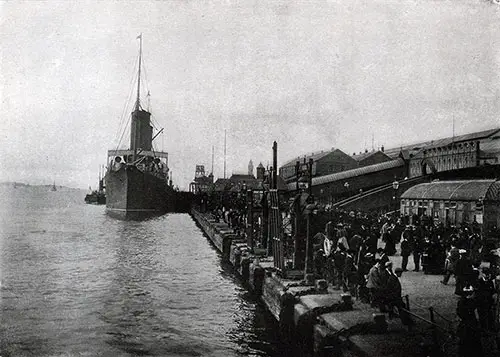
The Landing Stage and Riverside Railway Station at Liverpool, with a Cunard Liner Lying Alongside. GGA Image ID # 1000de8ca0
It is no empty platitude to say that in the realization of the immense development which is summarized in these few lines, the Cunard Company has been an important factor. It is interesting, therefore, to note that the progress of the Cunard Company has been continuous from the very outset of its existence.
The sea-going achievements of the four original vessels were regarded as so satisfactory that, in 1843, the Hibernia, and, in 1845, the Cambria, were built and launched, their gross tonnage being increased from 1,154 to 1,422 tons each, and the engine capacity from 740 to 1,040 horse power, while the passenger accommodation was improved in corresponding measure.
When, in 1847, the first mail contract expired, the Government were so fully satisfied with the manner in which its conditions had been observed that it was renewed for a further period of seven years, although on more ambitious lines.
The mail service was to be a weekly one, and the Government called upon the Company to build four more steamers of still larger size and greater steaming caliber.
The vessels were to be able to carry the heaviest guns then manufactured, and while the service from Liverpool was to be weekly, the ports of arrival on the other side were to be New York and Boston alternately.
The Government subsidy was under the new arrangement increased to 1173,340 annually, and as the immediate result, four paddle steamers, each of 1,825 tons gross register, and 2,000 horse power, and measuring 251 feet long, were built, and named the America, Niagara, Canada, and Europa.
The improved service thus rendered possible was inaugurated none too soon, for competition from the United States was not only threatened, but before long actively instituted by a syndicate of American merchants, who established themselves under the name of the Collins Line.
With a fleet of five large and powerful steamships, and heavily subsidized by the American Government, the new Line commenced operations with the avowed object of sweeping the Atlantic of the Cunarders."
The struggle was a fierce one while it lasted, but it was fought by the Cunard Line with the surest weapons. They would sacrifice nothing that was calculated to prejudice the safety of their ships or the lives of their passengers.
On the contrary, their efforts were consistently directed towards increasing the safety and comfort of those who supported them by adding new vessels to their fleet, each more powerful, commodious and completely equipped than its predecessor.
Thus it was that in 1850 the Asia and Africa were floated, followed two years later by the Arabia. In 1855 the first iron vessel for the Company's Atlantic service, the Persia, was launched, and in 1862 the almost sister vessel, the Scotia (Shown Below), the last of the old paddle-wheelers.
Meanwhile, the Collins Line, unable to keep pace with the rapid progress and persistent energy of the Cunard Company, had collapsed, having lost two ships and the American Government having refused to continue the subsidy.
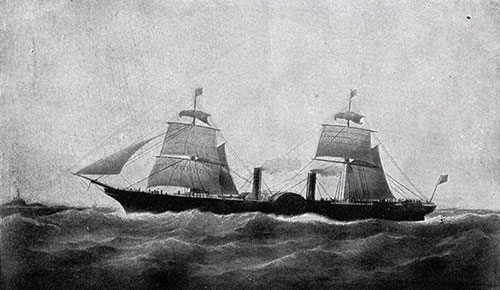
The Scotia, the Last of the Cunard Paddle-Wheel Liners. GGA Image ID # 10014c0c79
While thus ended the first serious attempt to compete for the Trans-Atlantic traffic, the Cunard Company had ever to be on the alert lest their prestige should suffer at the hands of others, for now further Atlantic services were being started between Glasgow, Southampton and Cowes and American ports.
The Persia and Scotia, however, were the favorite liners with passengers. So far the Cunard Company had, in deference to the preferences of most travelers at that time, adhered to paddlewheel propulsion, but they were, nevertheless, convinced of the superiority of the screw propeller, which marine engineers had long been actively advocating.
They had, indeed, been using screw steamers in their Mediterranean service, and the Inman Line had already introduced the screw system in their Atlantic service.
They decided for the future to adopt the screw, and so it was that the Scotia, the handsome vessel illustrated above, was, as has been stated, the last of their paddle-wheel liners; and the writer well remembers her lying at anchor in picturesque idleness in the Gareloch, off the Clyde, in the late seventies, when withdrawn from her Atlantic career.
SS Russia and Setting Departure Dates
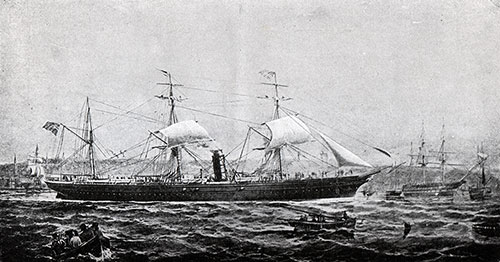
A Famous Cunarder - The Russia | Image ID # 46a1918f89
The first screw Cunarder for the Atlantic service, the China, was ordered in 1862. Regarded somewhat in the light of an experiment, her dimensions were smaller than those of the Persia and Scotia, her length being 326 feet by 40 feet 5 1/2 inches in beam.
Her gross register was 2,539 tons, and her indicated horse power 2,250, which was capable of giving an avenge speed of 13.9 knots.
Having adequately fulfilled the expectations of her owners and builder, the China was succeeded in 1865 by the Java, and two years later by the Russia (Shown Below), which was generally regarded as the most beautiful ocean-going vessel then in existence.
Her graceful proportions were regarded by practical men as the acme of nautical symmetry, and the beauty of her decorations and completeness of her equipment were the delight of passengers.
Built by the then firm of Messrs. J. & G. Thomson at their famous Clydebank shipyards, she was 358 feet long (21 feet shorter than the Scotia) by 42 feet 6 inches in beam, and 29 feet 2 inches in molded depth.
Her gross register was 2,960 tons, and her engines of 3,100 horse power gave her a speed of 13 knots in actual service, with a coal consumption of 90 tons per day, as compared with the 159 tons consumed by the Scotia to attain the same speed.
She had accommodation for 235 cabin passengers, and a cargo capacity of 1,260 tons. Her commander, Captain Cook, navigated her no less than 630,000 miles without a single mishap or casualty of any kind, carrying the while no less than 26,076 cabin passengers.
After being sold to another company, she continued up to the present year to maintain her splendid sea-going traditions.
Apart from the launch of the Russia, the year 1867 was in other particulars a noteworthy one in the history of the Cunard Line. When in that year the Company's arrangement with the Admiralty expired, the Postmaster-General had taken charge of the mail packet services.
In the new contract, however, it was stipulated that the Company should despatch a steamer every Saturday from Liverpool to New York, calling at Queenstown for the mails, and returning from New York every Wednesday, with a call at Queenstown before proceeding to Liverpool.
By this time numerous competitors for the mail service had arisen, and the Government were, consequently, able to reduce their subsidy to £80,000, curtailing it the year following to £70,000, the contract further binding the Company to maintain for seven years a dual weekly service from Liverpool--to Boston every Tuesday, and to New York every Saturday.
It was found, however, that the amount paid for the service was manifestly inadequate, and when the mail contract was again renewed the work was paid for in accordance with the weight of the mail matter carried.
This arrangement continues in force at the present time, the Cunard Company having thus been the Atlantic Ocean mail carriers for a period of sixty-two years.
The popular mind has little conception of the magnitude of the Atlantic mail requirements. From the outset they have been uninterruptedly progressive, and there is now an annual carriage of at least 13,000,000 letters, ,post cards, newspapers and book packets across the Atlantic.
A large proportion of this quantity of mail matter is shipped from Liverpool by the Cunarders, and every Saturday afternoon a special American mail train leaves Euston Station, London, with a later batch, which is put on board the mail steamers when they call off Queenstown on Sunday mornings.
This. represents a very smart piece of work, the entire journey from Euston to Queenstown being ordinarily accomplished in about fifteen hours. On the homeward journey the mails are carried with corresponding celerity, and half an hour after the mail bags reach Euston they are delivered at the Mount Pleasant depot. An hour later still finds the postmen on their rounds delivering the American mail in the City of London.
Another year of historical importance in the annals of the Cunard Line was 1870, when the Company made a further advance from the conventions of ocean steamship practice by adopting the compound principle for their engines, instead of the old side lever system.
Although they had just added two fine iron screw vessels, the Abyssinia and Algcria, to their fleet, they purchased the Batavia, which was being built and equipped with compound engines for a company engaged in another trade, and followed this by an order for the Parthia, also fitted with compound engines, which, utilizing steam at high pressure, gave better speed results than engines of the old type.
The newer existing vessels were refitted with compound engines, and seven new steamers were similarly fitted, including the Gallia, launched in 1879, which was the last iron Cunarder to be built.
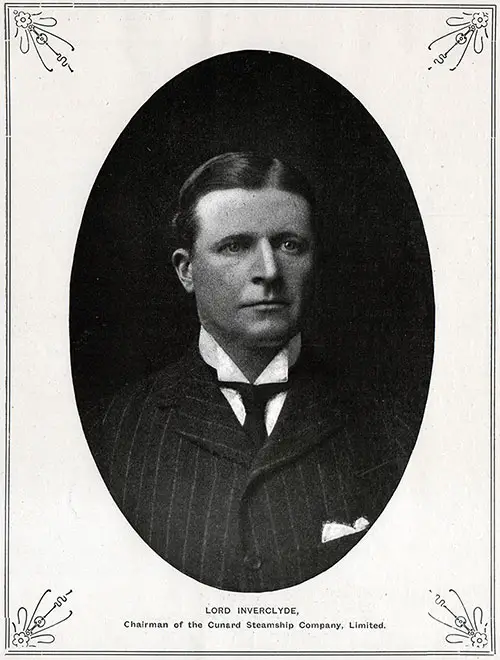
Chairman of the Cunard Steamship Company Limited - Lord Inverclyde. | GGA Image ID # 10000a53bd
In 1878 the Company, in order to consolidate the financial interests of the partners, was registered under the Limited Liability Acts, a joint stock Company being formed with a capital of £2,000,000, of which £1,200,000 was taken up by the Cunard, Burns and Maclver families.
It was not until 1880 that shares were issued to the public, and the prospectus then stated that " the growing wants of the Company's Trans-Atlantic trade demanded the acquisition of additional steamships of greater size and power, involving a cost for construction which might best be met by a large public company."
The available shares were immediately subscribed, and the directorate reconstituted. Mr. John Burns (afterwards Sir John Burns, Bart., and subsequently Lord Inverclyde), was elected Chairman of the Board, which position he held until his death in 1901, when he was succeeded by Mr. David Jardine. The present Chairman, Lord Inverclyde, whose portrait is shown above, is the son of the first Chairman.
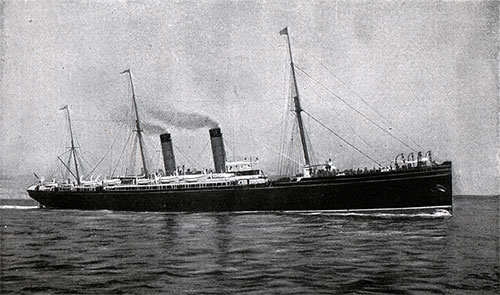
The Cunard Steamship Servia | GGA Image ID # 10007f167a
With the re-constitution of the Company successfully accomplished, the forward policy of the Cunard Line received a fresh impetus, of which the first important exemplification was the building of that magnificent vessel, the Servia, illustrated above, in 1881, by Messrs. J. & G. Thomson.
When the writer first boarded her in the Mersey in 1883, she was regarded as the " crack " liner in the Atlantic Ocean service, as she was also then the largest and most powerful steamship afloat, with the exception of the unfortunate Great Eastern.
She was also the first Cunarder to be built of steel instead of iron, and also the first to receive an electric installation. Her length was 515 feet, her beam 52 feet 3 inches, and her depth 40 feet 9 inches.
Her gross register was 7,392 tons, and her engines, indicating 9,900 horse power, enabled a speed of 16.7 knots to be realized on a daily consumption of 190 tons of coal, which reduced the Atlantic passage to 7 days 1 hour and 38 minutes. She was superbly fitted, and provided accommodation for 480 cabin and 750 third-class passengers.
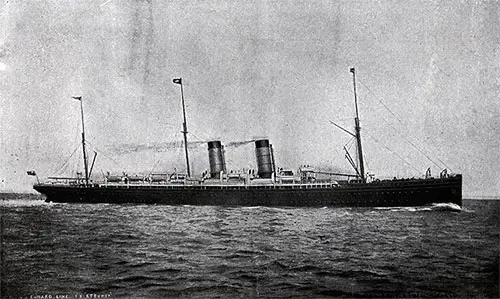
The Cunard Steamers The Umbria and the Etruria. GGA Image ID # 118f3d9e4c
The next additions to the Cunard fleet were the Catalonia, Pavonia and Cephalonia, which were placed upon the Boston service, and then, in 1883, came a new type of vessel in the Aurania, which, while 45 feet shorter than the Servia, was five feet wider in the beam -- a circumstance which enabled material improvements to be introduced in the accommodation for first-class passengers.
This same year saw the launching for another Atlantic line at the yard of Messrs. John Elder & Co., at Glasgow, of the Oregon, whose compound, direct-acting inverted engines developed 13,500 indicated horse power, and enabled a speed of 18 knots to be attained.
This sensational result immediately led the directors of the Cunard Line to order from the same builders two new vessels, which, while incorporating the best features of the Oregon, had others of their own, which, together, made the Umbria and Etruria, illustrated below, the fastest and finest ships then afloat.
With gross register of 8,127 tons, and engines indicating 14,500 horse power, a speed of 20 knots was secured. The Etruria, in its time, held the Atlantic record for speed, having accomplished the western passage in 5 days 20 hours and 55 minutes, and the eastern passage in 6 days 37 minutes.
But the Cunard had not yet reached the acme of its Trans-Atlantic ambition. In 1892 was launched the Campania, and in 1893 the Lucania, which mighty sister vessels are the fastest yet produced from British shipyards.
The dimensions of the Campania (Illistrated Below), which in every essential particular apply also to the Lucania, are these : length over all, 622 feet 6 inches; extreme breadth, 65 feet 3 inches; depth from upper deck, 43 feet; and gross tonnage, 12,950 tons.
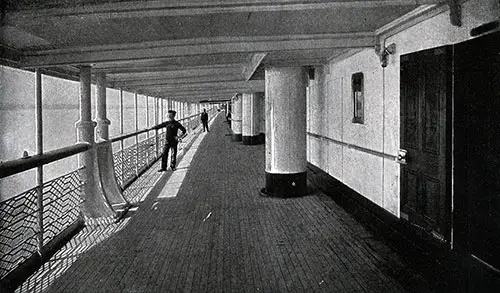
The Saloon Promenade of the Steamships Campania and the Lucania. GGA Image ID # 118f55a2e1
The vessel has, to quote technical detail, " a straight stem and elliptical stern, top-gallant forecastle and poop, with close bulwarks all fore and aft, the erections above the upper deck consisting of two tiers of deck houses, surmounted respectively by the promenade and shade decks.
She appears in fore and aft rig, with two pole masts." In her construction the greatest care had to be observed to maintain the requisite strength throughout the entire structure, and every advantage was taken of improved sections of steel so as to secure the maximum of strength without unduly increasing the total weight.
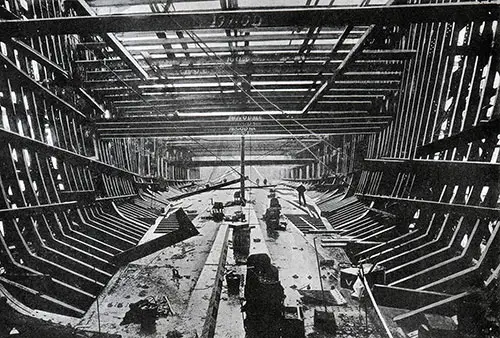
The Building of the Cunard Steamship Campania. The Vessel's Skeleton Framework is Shown. GGA Image ID # 118f7dedc0
There are sixteen bulkheads in the vessel, and she is capable of floating if any two, or in some cases three, are open to the sea. The decks have been strengthened to enable them to carry guns, and in other particulars the Campania complies with the requirements of the Admiralty as regards armed cruisers for service in time of war.
The vital parts of the ship are adequately protected; the steering is of a special type and is under the water line, as are also the rudder arrangements. There are four complete decks--the upper, main, lower and orlop--the first three being entirely devoted to passenger accommodation, and the last to cargo, refrigeration chambers, storage purposes, etc.
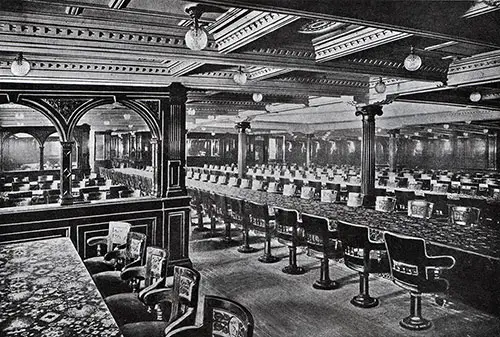
The Grand Dining Salon of the Cunard Steamships Campania and the Lucania. GGA Image ID # 118fcd81e2
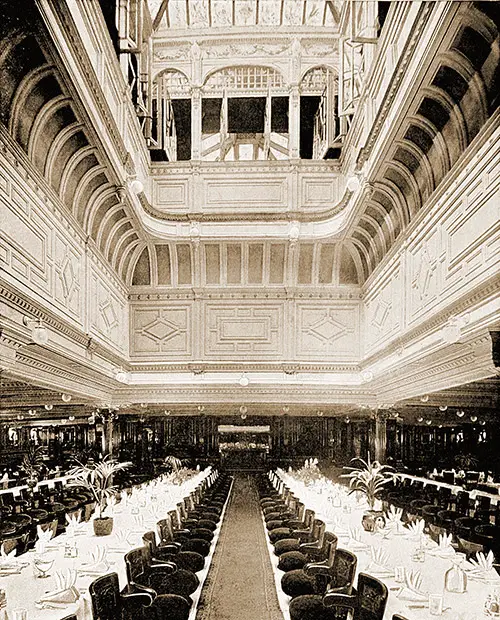
The Grand Dining Saloon of the Cunarders Campania and the Lucania Showing the Interior of the Dome. GGA Image ID # 118feabee8
The entire internal equipment has been based on lines calculated to promote the safety, comfort and enjoyment of ocean travel. For example, the casings round the boiler rooms are double, the intervening spaces being filled with material which is a non-conductor both of heat and sound.
The ventilation arrangements, both natural and artificial, are of the most complete description, as is also the sanitary equipment, while the " living " spaces are warmed by a system of steam-heated pipes.
The electric lighting installation, by Messrs. Siemens & Co., is on a most elaborate scale, there being four sets of generating plant, capable of supplying 1,350 16-candle power incandescent lights, besides a powerful search-light. No fewer than 40 miles of wire run through the ship.
The furnishings and decorations of the interior of the Campania are of the most sumptuous and luxurious description, having gained for the vessel its reputation for being the most palatial and magnificent in the world.
Some idea of the splendor of the appointments may be gained from the illustrations. The first-class dining saloon, illustrated above, which will seat 430 passengers at table, is a superb hall 100 feet long by 63 feet broad.
The general effect of the dark rich mahogany walls, the graceful arches, and the paneled ceiling in white and gold, surmounted by a great crystal dome (shown at right), rising through the two decks above to a height of 33 feet, and the dark russet velvet upholstery, is most impressive, and suggests a palatial structure on terra firma rather than a floating temple of luxury.
The drawing room on the promenade deck (illustrated below) is another sumptuously-appointed apartment in the Renaissance style, its appointments including a fine organ and grand piano.
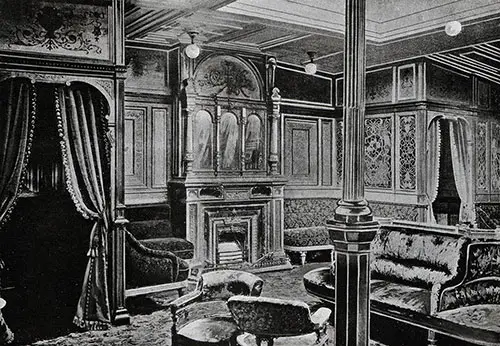
The Drawing Room of the Cunard Steamships Campania and the Lucania. GGA Image ID # 11901ce30c
The smoking room (below) is furnished in the Elizabethan style, and is a most popular retreat amongst the " mere men."

The First Class Smoking Room of the Cunard Steamship Campania As It Appeared Previous to Refurbishing. GGA Image ID # 11901e8c86
The library (below) is another elegant and appropriately-appointed apartment, and the main staircase and the grand entrance thereto may also be cited as examples of the lavish scale of the general decorative scheme, of the details of which considerations of space forbid more exhaustive description.
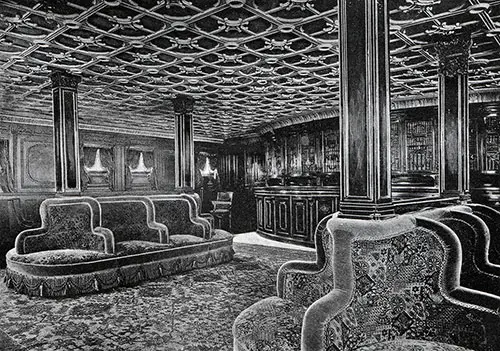
The Library of the Steamers Campania and the Lucania. GGA Image ID # 119027dcd0
The saloon accommodation on the Campania is situated amidships, the second-class cabins aft, and the third-class accommodation forward. Then there are some eighty-five second-class state rooms of various sizes, besides a handsome dining saloon, an adequately-furnished drawing room, and a comfortable smoking room.
Of this accommodation, as well as that which is devoted to the third-class passengers, which is in every respect excellent, and an immense improvement on the sort of thing which constituted the " steerage " of earlier days, several illustrations are given below, which speak for themselves.
Speed, Safety, Comfort and Luxury
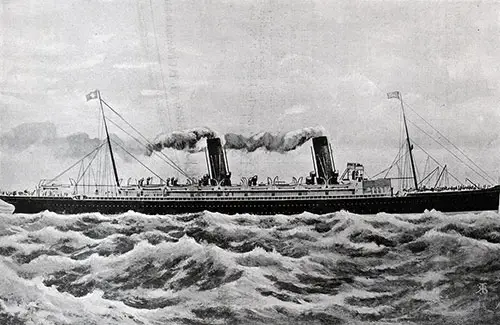
The Cunard Steamship Campania, Shown at Sea. GGA Image ID # 11902c6c82
Next to safety, the considerations which have chiefly weighed with the Cunard Company are those of speed and of the comfort, not to say the luxury and enjoyment, of the passengers. Sufficient has, perhaps, already been said to emphasize the success which has followed the enterprise and efforts of the Company in these particulars.
Under such auspices, ocean travel has been robbed of the hardships, indeed terrors, with which it was formerly associated. In this connection the stewards' department has all-important functions to serve, for the commissariat of a great ocean liner is a serious business.
The chief steward may have to cater for 500, 1,000 or 1,500 persons, for five, six, or seven days if the weather be fine, or for a longer period if it be stormy.
Here is the sort of provisioning which has been made for an average summer voyage of the Etruria, reckoning on 547 cabin passengers and a crew of 287 persons, and, if the figures be increased proportionately, the catering requirements for a voyage on the Campania can be approximated :
- 12,550 lbs. of fresh beef,
- 760 lbs. corned beef,
- 5,320 lbs. mutton,
- 850 lbs. lamb,
- 350 lbs. veal,
- 350 lbs. pork,
- 2,000 lbs. fresh fish,
- 600 fowls,
- 300 chickens,
- 100 ducks,
- 50 geese,
- 80 turkeys,
- 200 brace grouse,
- 15 tons potatoes,
- 30 hampers vegetables,
- 220 quarts ice-cream,
- 1,000 quarts milk, and
- 11,500 eggs.
The quantities of wines, spirits, beer, etc., put on board for the round voyage. comprise : 1,100 bottles of champagne, 850 bottles claret, 6,000 bottles ale, 2,500' bottles porter, 4,500 bottles mineral waters, and 650 bottles of various spirits.
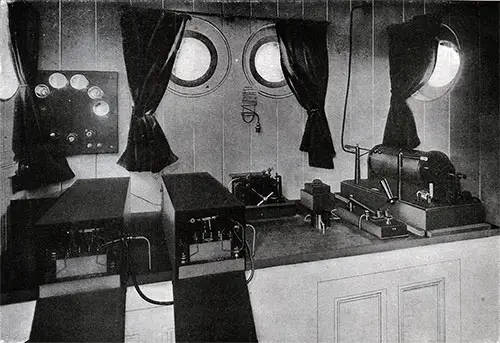
The Marconi System of Wireless Telegraphy: Instrument Room on Board a Cunarder. GGA Image ID # 11906c2bda
A new feature of ocean travel is the introduction of the Marconi system of aerial, or wireless telegraphy (Illistrated Above), which was first used in the Atlantic service on board the Lucania, and is now used on the other principal Cunarders as well.
The Marconi signaling station at Nantucket enables steamers to be reported in New York 13 hours earlier than was formerly the case, and 11 hours before the old signaling station on Fire Island is sighted.
Records are still being made in ocean telegraphy, but one worth noting was made when, on one occasion, the Lucania passed the Campania in mid-ocean . at 11 o'clock at night.
The vessels remained in wireless communication until 5 o'clock next morning, when they were separated by more than 180 miles ! In this connection the illustration of the instrument room on board the Campania, below, will be interesting.
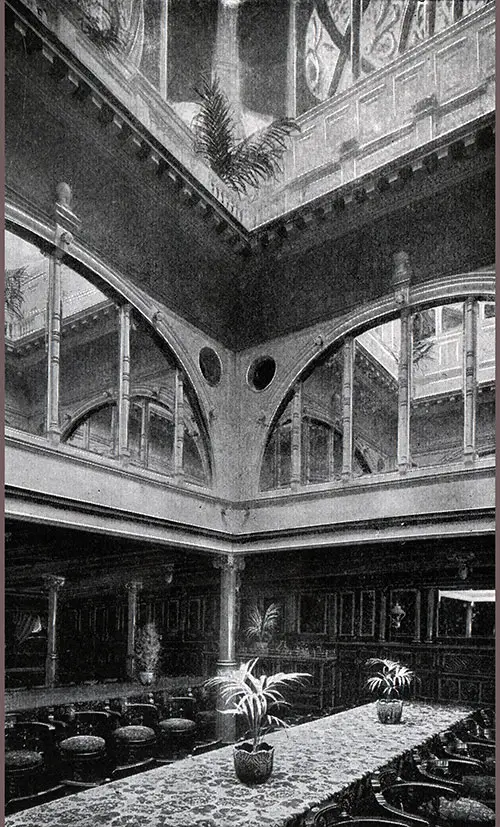
The Grand Dining Saloon of the Steamers Ivernia and the Saxonia Showing Interior of the Dome. GGA Image ID # 11907a8ad1
Although this article has been chiefly limited to the Cunard Line as a factor in the Atlantic trade, it should be remembered that the Company have a large steam fleet trading between Liverpool and Mediterranean ports.
They own at present 17 vessels, having an aggregate tonnage of 122,164 tons, and about 145,358 horse power. Irrespective of the vast employment which the building of their new vessels afford in different parts of the country, the Cunard Company find occupation for some 6,000 men afloat and ashore.
The administration of the Cunard Company is controlled by a Board of Directors, of which Lord Inverclyde is Chairman, and Mr. William Watson, Deputy-Chairman, its other members being Sir William B. Forwood and Messrs. Wilfrid A. Bevan, Alfred A. Booth, Ernest H. Cunard (a grandson of the founder), M. H. Maxwell, Jr., and John Williamson.
The general management is in the hands of Mr. A. P. Moorhouse, while the responsible offices of Secretary and General Superintendent are held by Mr. A. D. Mearns and Mr. James Bain, R.N.R., respectively.
It should be mentioned that the headquarters of the Company are at Liverpool, the chief offices being at 8, Water Street, and 1, Rumford Street, in that City.
There are also branch offices at London, Manchester, Glasgow, Leith, Queenstown, Belfast, Paris, Havre, Chicago, New York and Boston, while there are agencies in many of the principal cities and commercial centers of the United Kingdom and the Continent of Europe, and sub-agencies almost everywhere.
And now, in taking leave of the Cunard Line, whose interesting story has been told in brief epitome, it need only be added that the Company owning it proceeds upon its course, under .the new auspices mentioned at the outset of this article, with vigor unimpaired and resources undiminished.
What the future has in store for the Cunard Line time alone can show, but its prospects may, at least, be regarded as encouraging. Certain it is that its policy will be still progressive, and that its traditions will be fully maintained— traditions which add glory to the stirring tale of ocean travel, and the interest of romance to the story of THE GREAT ATLANTIC FERRY.
Second Cabin and Third Class accommodations, occupied by tourists and immigrants alike are typical of what the passengers found circa 1900 on board the steamships of the Cunard Line.
Typical Accommodations On Board the Cunard Steamers
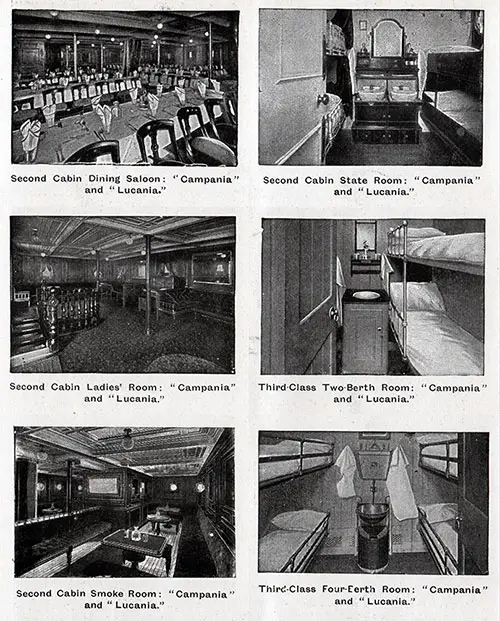
Second Cabin and Third Class Accommodations Typically Found on Cunard Steamships. GGA Image ID # 1190b4c422
Image Captions (L to R, T to B)
- Second Cabin Dining Saloon. Campania and Lucania
- Second Cabin State Room: Campania and Lucania
- Second Cabin Ladies' Room: Campania and Lucania
- Third-Class Two Berth Room: Campania and Lucania
- Second Cabin Smoke Room: Campania and Lucania.
- Third-Class Four-Berth Room: Campania and Lucania.
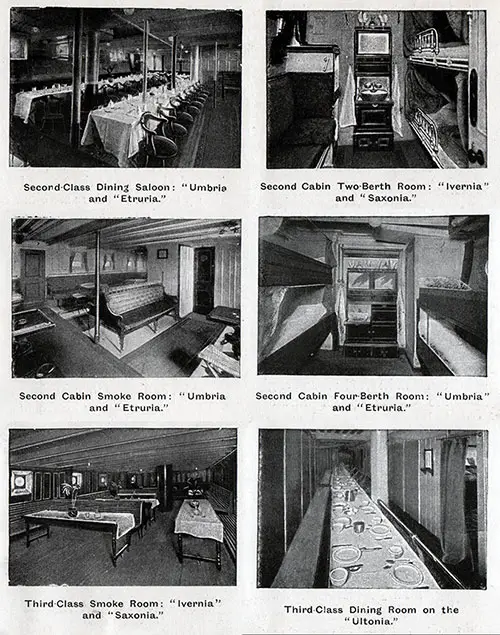
Additional Second Cabin and Third Class Accommodations Typically Found on Cunard Steamships. GGA Image ID # 1190d08541
Image Captions (L to R, T to B)
- Second-Class Dining Saloon : Umbria and Etruria
- Second Cabin Two-Berth Room : Ivernia and Saxonia
- Second Cabin Smoke Room : Umbria and Etruria
- Second Cabin Four-Berth Room: Umbria and Etruria
- Third-Class Smoke Room: Ivernia and Saxonia
- Third-Class Dining Room on the Ultonia
1902 Brochure of the Cunard Steamship Company
- Date of Publication: December 1902
- Published by: Cunard Steamship Company, Limited - A Reprint of an article apearing in the magazine Business Illustrated.
- Number of Pages (with Text or Images): 33
- Number of Photographs: 13
- Number of Illustrations or Drawings: 26
- Number of Diagrams: 1

